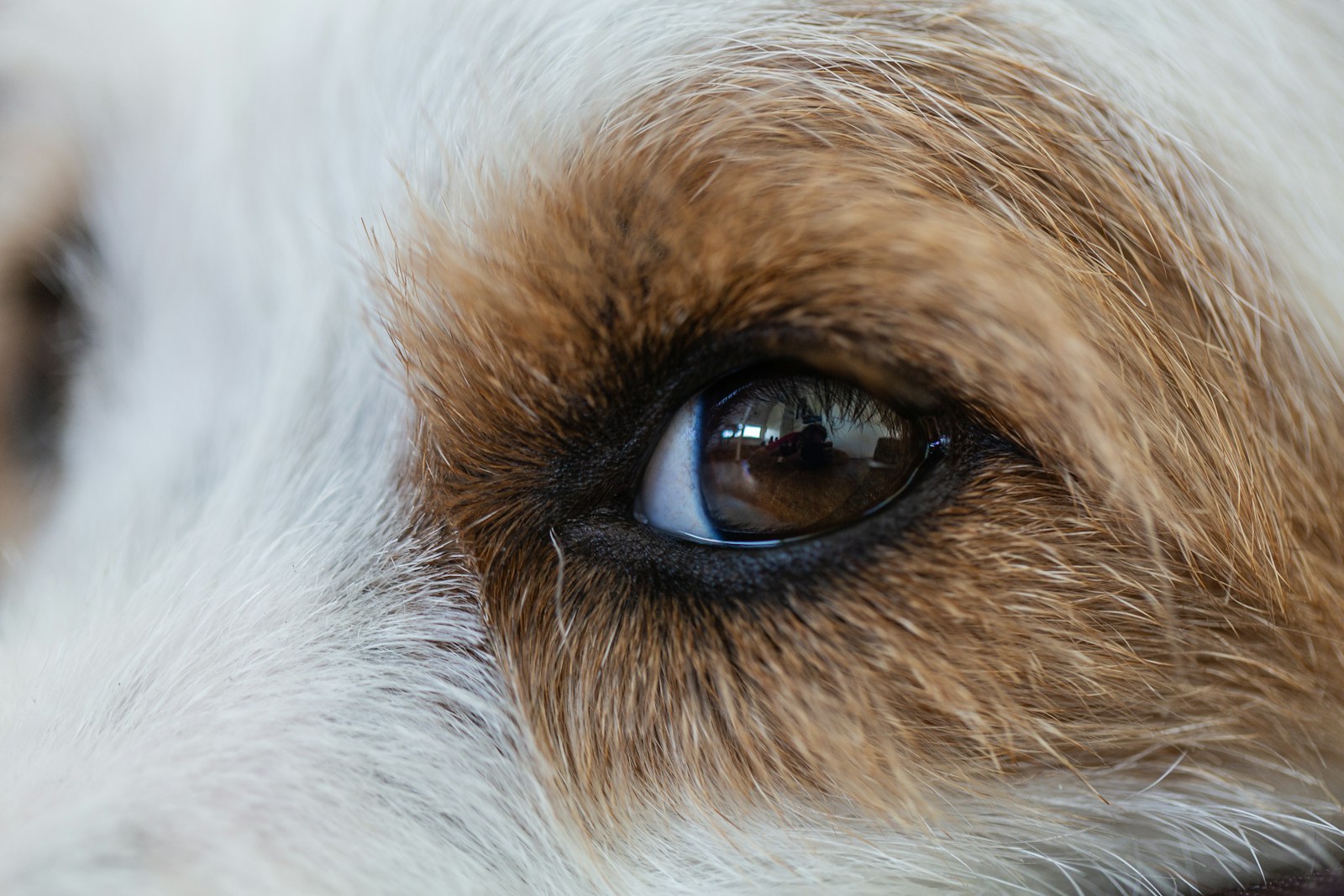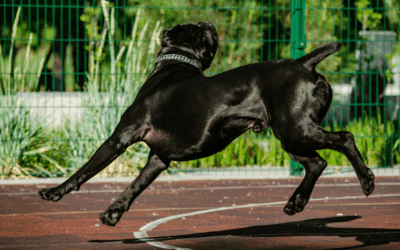Have you ever wondered what the world looks like through your dog’s eyes? How do dogs see the world?
While we often assume our canine companions see the world the same way humans do, their vision is remarkably different. From their ability to see in dim light to detecting motion more effectively, dogs experience their surroundings in a way that’s both unique and fascinating.
In this blog post, we’ll explore the science behind dog vision, how it compares to human eyesight, and what makes their eyes so special. By the end, you’ll have a better understanding of how your furry friend perceives the world!
Why Canine Vision is So Important
Canine vision plays a crucial role in a dog’s survival, behavior, and interaction with the world. Below are some key reasons why their eyesight is vital:
Detecting Movement
Dogs are excellent at detecting motion, even at a distance. This ability is essential for activities such as hunting, herding, or guarding their territory. Their acute motion detection helps them respond quickly to potential threats or opportunities, making it a vital aspect of their instincts.
Enhanced Night Vision
Thanks to their tapetum lucidum, a reflective layer in their eyes, dogs can see much better in low-light conditions than humans. This adaptation allows them to navigate and remain alert during dusk, dawn, or nighttime, when visibility is limited for most creatures.
Perceiving Their Environment
A dog’s vision, combined with their other heightened senses like smell and hearing, helps them build a detailed understanding of their environment. This sensory synergy enables them to master tasks such as locating their owners, recognizing familiar spaces, or even detecting subtle changes in their surroundings.
Improved Hunting and Survival
Vision is integral to a dog’s ability to locate prey, gauge distances, and assess movement in the wild or during play. While modern domesticated dogs rarely need to hunt, their vision remains key to survival instincts and their overall activity.
Social Interaction
Dogs often rely on visual cues to understand the emotions and intentions of humans and other animals. Through observation, they interpret body language, facial expressions, and hand signals, making vision essential for communication and bonding.
Understanding the importance of canine vision is not only fascinating but also underscores why it’s crucial to prioritize their eye health. Regular checkups and attention to changes in their behavior can help ensure they maintain their sharp visual abilities throughout their life.
How are Dog Eyes Different from Human Eyes?
When it comes to vision, dogs and humans share some similarities, but there are several key differences:
1. Rods vs. Cones
The retina, located at the back of the eye, is filled with light-sensitive cells called rods and cones. Rods are responsible for detecting light and motion, while cones help perceive color. Humans have three types of cones, which allow us to see a wide range of colors like red, green, and blue. Dogs, on the other hand, have only two types of cones, enabling them to see a limited color spectrum.
This means dogs see the world mostly in shades of blue and yellow. Colors like red and green appear as muted shades, making their world much less colorful than ours. For example, a bright red ball might look like a dull shade of gray or brown to your dog.
Rods in Dog Eyes
Rods are a type of photoreceptor cell found in the retina of a dog’s eye. They play a crucial role in enabling vision in low light or nighttime conditions, making them particularly important for dogs, who are naturally more active during dawn and dusk. Compared to humans, dogs have more rods in their retinas. This abundance allows them to detect movement and shapes more effectively in dim environments, giving them a significant advantage in scenarios where light is limited.
The high density of rods also means that dog eyes excel in the ability to see well in the dark, although this comes at the expense of perceiving fine details or vibrant colors, which are more dependent on cone cells. This adaptation stems from their evolutionary history as hunters, requiring keen vision during crepuscular times when prey is often most active. Understanding the role of rods highlights the incredible visual adaptations of dogs and reminds us of the importance of environments and activities suited to their unique visual capabilities.
Cones in Dogs Eyes
Cones are photoreceptor cells in the retina that are responsible for detecting color and functioning in bright light conditions. Unlike rods, which are more adapted for low-light vision, cones allow dogs to perceive some degree of color, albeit not as vividly or across as broad a spectrum as humans. Dogs possess fewer cone cells compared to humans, and they only have two types of cones, while humans have three.
This means that dogs primarily see in a limited color range, often described as shades of blue and yellow, and are essentially red-green colorblind.
This dichromatic vision might seem restrictive by human standards, but it suits dogs’ needs perfectly. Their cone cells are fine-tuned for recognizing essential contrasts in their environment, such as distinguishing prey or objects from the background during daylight hours. Understanding how cones function in their eyes highlights the remarkable ways evolution has tailored dogs’ vision for their survival and lifestyle.
Key Takeaway:
While humans experience a vibrant world full of color, dogs focus on functionality. Their vision is tailored for detecting motion and thriving in low-light conditions, which brings us to the next point…
2. Night Vision
Dogs’ eyes are designed to perform exceptionally well in dim light or at night. Thanks to an abundance of rods in their retinas, their eyes are more sensitive to light than human eyes.
Additionally, dogs have a special layer in their eyes called the tapetum lucidum, which reflects light back through the retina. This reflection amplifies light input, giving dogs their signature “glowing eyes” in the dark.
Why It Matters:
This adaptation allows dogs to see clearly in low-light environments, a trait inherited from their ancestors who hunted at twilight. While humans struggle to see in the dark, dogs excel, making them perfect nighttime companions.
3. Visual Acuity
Although dogs thrive in dim lighting and are great at detecting motion, their visual acuity (or clarity of vision) is less sharp than that of humans. What appears sharp and well-defined to us might look a lot blurrier to dogs. This is because human eyes have more cones packed into the retina’s center, allowing us to notice finer details.
For dogs, the world is all about the big picture. They prioritize movement and shapes over intricate detail. This is why your pup might bark at a moving object far away but not notice a stationary one close by.

How Do Dogs See Movement and Perceive Space?
Dogs are movement experts. Due to the higher number of rods in their retinas, dogs see motion far better than humans do. This explains why your dog can notice a squirrel dashing across the yard in an instant or become alert when a leaf flutters past the window.
Additionally, dogs have binocular vision, which allows them to judge the distance of objects. However, their peripheral vision is broader than ours, giving them an increased field of view. For example, most breeds have around a 240-degree field of view, compared to the human field of around 180 degrees.
This increased peripheral vision comes at a slight cost to depth perception, especially in smaller breeds or those with flat faces, like pugs or bulldogs. Larger breeds with long snouts tend to have fewer blind spots and slightly better depth perception.

How Colors Look to Dogs
While dogs can only see two colors, blue and yellow, they’ve adapted to use other cues to identify objects. For example, they rely heavily on smell and contrast. A red toy on green grass might look like varying degrees of gray to dogs, but they can easily spot it due to its shape or movement.
Additionally, they use their excellent sense of smell to track objects. For dogs, their nose complements their eyes, creating a complete sensory experience.
What Happens if a Dog Experiences Vision Problems?
Like humans, dogs can experience vision problems such as cataracts, retinal degeneration, or blindness. However, blind dogs adapt incredibly well to their surroundings by relying on their sense of smell, hearing, and touch. Non-visual cues become their primary way of navigating the world.
If your dog’s behavior changes or they seem disoriented, a visit to a veterinary ophthalmologist might help identify any underlying issues with their vision.
Why Dogs See the World Differently
The way dogs see their surroundings is perfectly tailored to their evolutionary needs. From detecting motion to navigating in the dark, their vision developed over thousands of years to make them skilled hunters and adaptable companions.
What’s most interesting is how their strengths in other senses, such as their exceptional sense of smell, harmonize with their unique eyesight to create a rich, multi-sensory way of experiencing the world.
For us humans, it’s fascinating (and heartwarming) to realize just how differently our pets perceive the same environment. Next time you’re on a walk with your dog, try imagining the world through their eyes. It just might bring you closer to understanding their behavior.
Helpful Resources on Canine Vision
American Kennel Club (AKC)
The AKC provides insights into various aspects of dog behavior, health, and training, including detailed articles about how dogs see the world.
VCA Animal Hospitals
VCA Animal Hospitals offer professional resources to understand dogs’ biological functions, including their vision and sensory perception.
PetMD
PetMD covers a wide range of topics related to pet health and behavior, with specific articles explaining how dogs experience visual stimuli.
National Geographic
https://www.nationalgeographic.com
Through engaging and informative articles, National Geographic explores the science of animals’ vision systems, including how dogs’ eyes differ from humans’.
Whole Dog Journal
https://www.whole-dog-journal.com
This publication focuses on canine health, training, and behavior, often featuring in-depth discussions about sensory topics like vision.
American Veterinary Medical Association (AVMA)
The AVMA provides trusted veterinary knowledge, including research about how dogs interact with their environment using their sensory capabilities.

Snouts and Stouts Indoor Dog Park and Bar is the perfect place for you and your pup to let loose. Visit us today!
Understanding Canine Vision Brings Us Closer | How Do Dogs See The World
Knowing how dogs see the world helps us better understand our canine companions, their behaviors, and their needs. Whether it’s choosing high-contrast toys, accommodating vision problems, or marveling at their ability to see in the dark, understanding their unique perspective strengthens the bond between us.
If you want to learn more about how to care for your dog’s specific needs, reach out to your vet or explore educational resources from trusted organizations. The more we know, the closer we grow.





